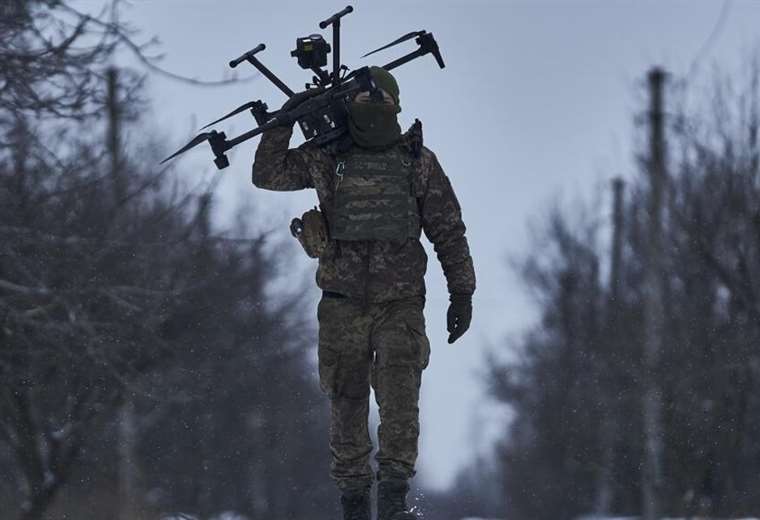May 8, 2023, 2:05 PM
May 8, 2023, 2:05 PM
Drone incidents have increased in recent months in the conflict between Russia and Ukraine. Moscow accuses the United States of being behind the alleged Ukrainian drone attack on the Kremlin. “A lie,” according to Washington. The drones target military bases and energy infrastructure on both sides of the border. Interview with Franck Lefèvre, Director of Defense Programs at ONERA (French National Office for Aerospace Studies and Research).
An interview with Clea Broadhurst
RFI: How far can drones travel?
Franck Lefevre: They can travel several tens of kilometers, depending on their autonomy. It depends on your size. There are drones with a wingspan of several meters, with a sufficiently powerful motor (thermal or electric motor) capable of transporting large loads over long distances. In addition, the conflict in Ukraine shows that a drone bought for one hundred euros can destroy an eight million euro tank. This is clearly demonstrated in Ukraine.
RFI: Does this conflict reveal the military power that can be obtained with little means, but much damage?
Franck Lefevre: The presence of armed drones in the theaters of operations is becoming increasingly important, as the Ukrainian conflict demonstrates, and this poses many difficulties. Until now, we used drones for reconnaissance. It was Florence Parly (former French Defense Minister) who first spoke about weaponized drones in 2017, and that’s when we put together our Reaper drones.
The difficulty we are facing today is that these are small drones capable of carrying payloads that can do a lot of damage. These drones are difficult to detect, partly due to their small size, but also because they are made of plastic or composite materials, which often requires a combination of several detection technologies, since conventional radar alone or technologies Infrared are not always enough; for example, drones with electric motors emit little infrared radiation and are therefore difficult to detect.
This is a real difficulty if one takes into account that these drones are freely accessible and, therefore, accessible to everyone. It is only necessary to transform them into a weapon. We have the example of the drone, which was not malicious, but which landed at Angela Merkel’s feet: we dare not imagine what might have happened if there had been an explosive charge inside.
RFI: So the main problem is detection?
Franck Lefevre: Yes, and that is precisely what we are working on at ONERA. Detecting a drone in an urban environment is relatively complex, since it is a dense environment in which it is difficult to distinguish a malicious object from another object. In addition, it must be taken into account that the neutralization phase is also complex, depending on the environment in which the drone is flying. Destroying a drone in the middle of the desert does not pose the same side effect problems as in an urban environment. Consequently, the phases of detection, recognition, identification and neutralization are complex and require means specifically adapted to this type of objective.
RFI: What specific type of equipment are you referring to?
Franck Lefevre: ONERA is working on several detection systems, considering that a combination of technologies will be necessary to face this type of threat. We are working on radar-based technologies. There are two types of radar, active radars that emit an electromagnetic wave that is reflected by the drone, allowing its detection. ONERA also works on so-called passive radars, that is, they use the existing electromagnetic environment, for example that of mobile telephone networks. These environmental waves are reflected by moving drones and radar detects these reflected signals. ONERA has developed this technology, which makes it possible to detect small drones -of a few tens of centimetres- several kilometers away.
ONERA is also developing optronic technologies, again of two types, passive or active. The so-called passive systems perform a classic observation of the scene, either in visible light or in infrared light. We are also developing active optronic systems, based on lasers, called Lidar (Light Detection And Ranging), which can be used to detect drones, illuminating the scene with a laser and detecting the photons reflected by the drone.
I repeat, the difficulty lies in detecting, recognizing and identifying and neutralizing, in a complex environment such as the urban one. One must be able to discriminate between threatening and non-threatening objects. The wingspan of a drone is sometimes close to that of a bird, for example. Therefore, we need systems that can make this distinction, and for this reason it is very likely that a detection system worthy of the name is a system that combines several technologies, such as radar and optronics, for example.
For this reason, ONERA also works on the fusion of data from different types of sensors, in order to provide reliable information to operational personnel, with the lowest possible rate of false alarms, thus allowing the identification of a threatening target. ONERA is also working on increasing the power of laser sources, one possible application being the neutralization of drones.
RFI: Are we going to see more and more “drone” conflicts?
Franck Lefevre: It is very probable. The drone has several advantages for the attacker: it is freely accessible, low cost, and can be operated safely. The conditions exist for this type of threat to proliferate.















